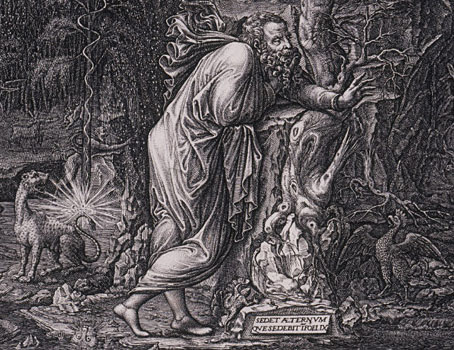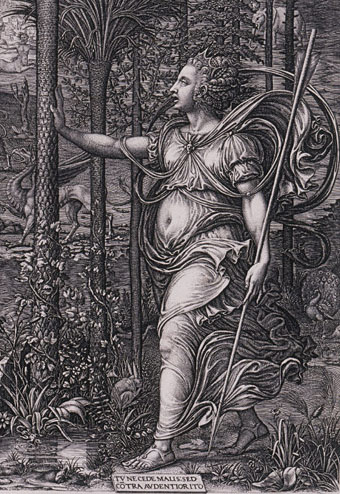Allegory of Life or The Dream of Raphael (detail, 1561).
The British Museum’s description:
This famous print is often called The Dream of Raphael, because the lettering at the bottom states that the design is by Raphael. However, the accumulation of incidental detail is wholly uncharacteristic of Raphael’s style and no one believes that it is by him. Nor has anyone completely explained the esoteric subject.
A boat has been wrecked by turbulent and rocky river, in the foreground. It points to the bearded man, who leans on the trunk of a dead tree, with a bat, two owls and a crow above him. In the lettered state of the plate (signed and dated 1561), the blank panel at the base of the tree is filled with an inscription from Virgil’s Aeneid VI, 617: SEDET AETERNVM / QVI SEDEBIT INFOELIX (“He will sit forever who sits unfortunate”). The man is surrounded by monstrous creatures who eye him venomously. His only hope appears to come from the goddess-like woman with a long spear who appears on the right. She might be Reason, come to rescue a philosopher, but with no explanation to help us, her significance remains obscure.
Ghisi (1520–82) was trained in the Italian engraving style pioneered by Marcantonio Raimondi. He left Rome in 1550 to join the Antwerp publishing enterprise of Hieronymous Cock, where he introduced Roman High Renaissance art to northern Europe through his reproductive engravings. He was in Paris from 1556 to 1567, where he probably engraved this allegory, his most famous print.
See the complete print at large size here.
Elsewhere on { feuilleton }
• The etching and engraving archive


